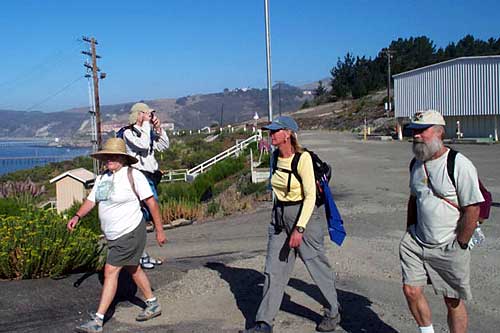


August 16, San Luis Obispo County Avila Beach to Pismo Beach State Park. 9.3 miles
Today was a somewhat lazy day as indicated by our total mileage. After cleaning up the rental house in Grover Beach, we drove back to Avila Beach to start the hike. With us were our two new section hikers who joined us the night before. They are Alexis Carlson and granddaughter Maria Perry.
Meeting us at the Avila Pier were several more additions to our days walk. Jeff Ferber, last with us on the Hearst Ranch property, rejoined us briefly to show before and after pictures of the Avila town restoration, a project his design firm worked on. Also in attendance were John and Pam Heatherington. Pam is the Executive Director of the San Louis Obispo Environmental Center. Philip Sadler, Ginnys husband and section hiker in Sonoma County has rejoined us for the weekend. Jan DiLeo, San Louis Obispo County Trails Planner came out to walk some of her trails, and also present was Bill Almas, who works for Unocal.
We began by not walking. We all identified ourselves for the public-access cable station and talked a bit about the expedition and its goals. Then Jeff talked about the Avila Beach restoration, which was started in 1999 and is nearing completion. For decades the Avila Tank Farm sat on the hill above the town. Crude oil from inland oil fields came by pipeline to these tanks and then was sent down into the town, out on the pier, and onto awaiting tankers. Refined petroleum products returned via the same pipes for local consumption. During World War II, diesel fuel for the Allied Forces in the Pacific left from Avila Beach. The end result was a great amount of pollution from leaks and cultural practices. (For example, erosion of the sandy soils was kept in check by spraying crude oil out over the ground!) This pollution was cleaned up, and the first block of the town, back from the beach, is being rebuilt.
While we were hearing this history, our Ginny was on the phone to the world via a live hook up with “The Satellite Sisters”, a syndicated radio program broadcast on Saturday mornings on the ABC network.
Finally, we started walking by going through the Avila Tank Farm. Unocal, the owners, still must clean up this area, and it is currently fenced off from the public. We hope that the pleasant uphill bluff road we walked can become a link in the California Coastal Trail, connecting eventually the town of Avila with the community on the other side of this hill where a trail has been put in along the street, which fronts a development of luxury homes.
The rest of our day was a combination of bluff, suburban street and beach walking. Lunch was taken at Margo Dodd Park. This is a little grassy bluff-top area with an island immediately offshore. This afforded us a wonderful chance to watch the many pelicans resting on it within a very short distance of our park. Then it was on past Dinosaur Caves Park, so named for a concrete dinosaur built in the 1940s as an entry to some sea caves. They were slated for development but finally rescued for a park and trail in June 2003 by local advocates with help from the Coastal Conservancy.
Before descending to the broad sands of Pismo Beach for the final mile or so to our camp, we walked around and through several large, expensive hotel and restaurant complexes, each of which had been required to provide public access. At one point our trail took us around the deck of the Shore Cliff Restaurant. Because of the configuration of cliffs with no beach below, and houses built to the edge of the cliffs, we walked up a few blocks, across, then down a few blocks several times in the course of our hike through Pismo Beach. The fog drifted in and out with us as we walked up or down these blocks. (Jon Breyfogle; photos by Linda Hanes)
Left: Avila Beach after cleanup and reconstruction. Right: Walking through the UNOCAL property above Avila Beach, source of the pollution.
For trail section - San Luis Obispo Section 10, San Luis Obispo Section 11
